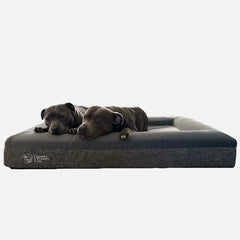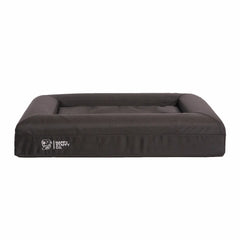Finding the right dog bowl might seem like a small decision, but it plays a big role in your pet’s health and comfort. The material of the bowl affects more than just how it looks—it impacts your dog's safety, the cleanliness of their feeding area, and even your long-term budget. With options like stainless steel, ceramic, plastic, silicone, and glass, each material comes with its own pros and cons.
Your choice of material can influence hygiene, durability, and overall convenience. Some bowls are better suited for active or messy eaters, while others prioritise aesthetics or portability. Whether you're looking for something stylish, travel-friendly, or built to withstand a chewer’s enthusiasm, understanding these differences is key to making the best decision for your furry friend.
Key Takeaways
-
Stainless steel bowls offer the best balance of durability, hygiene, and safety for daily use.
-
Ceramic dog bowls are ideal for calm eaters who benefit from stable, stylish, and lead-free feeding options.
-
Plastic bowls may be affordable, but they pose hygiene and health risks due to scratches and chemical leaching.
-
Silicone dog bowls work well as a lightweight, foldable option for travel or outdoor adventures.
-
Glass dog bowls suit pet owners who want an eco-friendly and non-toxic solution, though they require careful handling.
Factors to Consider When Choosing a Dog Bowl Material
Health and Safety
Your pet's safety should always come first. Some materials, like plastic, can contain harmful chemicals such as BPA, which may leach into food and water over time. These can pose serious health risks to your dog. Additionally, scratched surfaces—common in plastic bowls—can harbor bacteria, making them less hygienic. For dogs with allergies or sensitive skin, materials like stainless steel or lead-free ceramic are better choices because they are hypoallergenic and non-toxic.
Durability
Durability is another crucial factor, especially for dogs who love to chew or push their bowls around during meals. Stainless steel is one of the most durable options, resisting dents, scratches, and rust. On the other hand, ceramic bowls, while sturdy, can chip or break if dropped. Silicone and plastic are less durable but may be sufficient for smaller dogs or travel purposes. Choosing a durable material ensures your investment lasts longer and remains safe for your pet.
Hygiene and Ease of Cleaning
Maintaining a clean feeding area is essential for your dog’s health. Materials like stainless steel and glazed ceramic are non-porous, making them resistant to bacteria and easy to clean. Dishwasher-safe options are particularly convenient for busy pet owners. Conversely, plastic bowls are prone to scratching, which can trap food particles and lead to bacterial buildup. Regular cleaning and inspection are especially important for maintaining hygiene, regardless of the material.
Cost and Budget
Dog bowls come in a wide price range, from budget-friendly plastic to premium ceramic and stainless steel options. While cheaper bowls might save money initially, they often require frequent replacement due to wear and tear. Investing in a high-quality material, like stainless steel, may have a higher upfront cost but typically saves money over time because of its durability and ease of maintenance.
Aesthetic and Practical Needs
The material of your dog’s bowl should also fit your lifestyle and your home. Ceramic bowls offer stylish designs that blend seamlessly into modern home décor, while stainless steel bowls provide a sleek, utilitarian look. If portability is a priority—for example, for outdoor adventures or travel—lightweight materials like silicone or plastic may be more practical. The right choice balances style, function, and convenience to suit both you and your pet.
Comparison Table of Dog Bowl Materials

Popular Dog Bowl Materials
Choosing the right material for your dog’s bowl isn’t just about function—it’s about finding the perfect balance of safety, durability, and practicality. Let’s dive into the most common materials and evaluate their pros and cons to help you make an informed choice. While each material has its merits, stainless steel stands out as a versatile and reliable option for many pet owners.
Stainless Steel
Stainless steel dog bowls are a favorite among pet owners for a good reason. This material is incredibly durable, making it a long-term investment for your pet’s feeding needs.
Pros:
- Highly Durable and Rust-Resistant: Stainless steel bowls are tough, long-lasting, and resistant to rust, making them perfect for daily use and outdoor settings.
- Hygienic and Easy to Clean: The non-porous surface prevents bacterial growth and food residue, and most bowls are dishwasher safe for effortless cleaning.
- Odor and Stain Resistant: Stainless steel doesn’t absorb odors or discolor over time, ensuring a consistently clean feeding experience.
- Protective Powder Coat Finish: Adds a stylish touch while protecting against rust, fading, and scratches.
- Non-Slip Rubber Base: Keeps the bowl stable during mealtime and prevents scratches on your floors.
- Versatile Options: Available as slow feeders, standard feeding bowls, and insulated water bowls for all your pet’s needs.
- Safe Materials: Made with 304 18/8 food-grade stainless steel, free from BPA, lead, and other harmful chemicals.
Cons:
- Noise Levels: Can produce clanking sounds if dogs push or move the bowl on hard surfaces. A non-slip mat or rubber base can help minimise this issue.
- Temperature Sensitivity: Can become hot or cold depending on the environment, so avoid placing the bowl in direct sunlight or freezing conditions.
- Appearance Maintenance: May develop minor scratches or water spots over time, requiring occasional polishing for a pristine look.
Ceramic
Ceramic bowls are a stylish option for pet owners who value aesthetics and want something that blends seamlessly into their home décor.
Pros:
- Stylish Designs: Ceramic bowls come in a variety of colors, patterns, and finishes, allowing you to match your pet’s bowl to your personal style.
- Stable and Tip-Resistant: Their weight makes them less likely to be tipped over, making them a good choice for messy eaters.
- Glazed for Easy Cleaning: Glazed ceramic surfaces are smooth and easy to clean, ensuring hygiene when properly maintained.
Cons:
- Fragility: Ceramic bowls can chip or crack, especially if dropped or handled roughly. A cracked bowl may harbor bacteria, posing a health risk to your pet.
- Lead-Free Certification Required: Always ensure the glaze used on ceramic bowls is lead-free for safety.
Ceramic bowls may be a good fit for calm, less active dogs, but they require careful handling to ensure longevity and safety.
Plastic
Plastic bowls are a budget-friendly option, often chosen for their affordability and lightweight design. However, they come with some significant drawbacks.
Pros:
- Lightweight and Affordable: Plastic bowls are easy to move around and are usually the most cost-effective choice.
- Variety of Colors and Shapes: They’re available in a wide range of styles, making them appealing to pet owners seeking fun designs.
Cons:
- Prone to Scratches: Over time, plastic bowls develop scratches that can harbor bacteria, making them harder to clean effectively.
- Chemical Concerns: Some plastics may contain harmful chemicals like BPA, which could leach into food or water.
- Low Durability: Plastic bowls can warp, crack, or fade with regular use, especially if exposed to sunlight or rough handling.
Plastic bowls are best suited for short-term use or as a lightweight travel option but may not be the best for long-term feeding needs.
Silicone
Silicone bowls are designed with portability in mind, making them a great option for on-the-go feeding during travel or outdoor adventures.
Pros:
- Portable and Lightweight: Silicone bowls are flexible and foldable, making them easy to carry on trips or hikes.
- Non-Toxic and Heat-Resistant: High-quality silicone is food-safe and can handle hot or cold items without degrading.
- Easy to Clean: Most silicone bowls are dishwasher safe, simplifying maintenance.
Cons:
- Less Durable: While convenient for travel, silicone lacks the sturdiness needed for everyday use, especially for dogs who like to chew.
- Chew Risks: Aggressive chewers may quickly damage silicone bowls, reducing their lifespan.
Silicone bowls are an excellent secondary option for travel but may not replace a durable stainless steel bowl for daily use.
Glass
Glass bowls bring an eco-friendly and stylish touch to your pet’s feeding setup. They’re often chosen for their sleek appearance and non-toxic properties.
Pros:
- Non-Porous and Hygienic: Glass doesn’t retain stains, odors, or bacteria, ensuring a clean eating experience.
- Environmentally Friendly: Glass is recyclable, making it a sustainable choice for eco-conscious pet owners.
- Aesthetic Appeal: Glass bowls are elegant and blend well with home décor.
Cons:
- Fragile: Glass bowls are prone to breaking or chipping, making them unsuitable for active dogs or homes with small children.
- Heavy and Less Portable: Their weight makes them difficult to move around, especially for travel.
While glass bowls are hygienic and visually appealing, they’re better suited for calm, adult dogs and require careful handling.
Safety Tips for Choosing and Maintaining Dog Bowls

Selecting the right dog bowl is just the beginning—proper care and regular inspection ensure your dog stays safe and healthy. Here’s how to keep your dog’s bowl in top condition, regardless of the material.
How to Inspect Materials for Wear and Tear
- Stainless Steel: Check for dents, scratches, or discoloration that could trap bacteria or compromise its rust resistance. Replace bowls showing significant wear.
- Ceramic: Examine for chips, cracks, or a damaged glaze, as these can harbor bacteria and make cleaning ineffective.
- Plastic: Look for scratches, warping, or fading. These signs indicate it’s time for a replacement to avoid bacterial buildup or chemical leaching.
- Silicone: Inspect for tears or chew marks, especially if your dog is a chewer. Damaged silicone can lose its non-toxic integrity.
- Glass: Look for chips, cracks, or sharp edges that could harm your pet or contaminate food.
Signs of Contamination or Harmful Residues
- Odors or Stains: Persistent odors or discoloration indicate bacterial growth or contamination, especially in plastic or ceramic bowls.
- Slimy Residue: A slimy feel, even after washing, suggests biofilm buildup—a sign of bacterial contamination.
- Flaking or Peeling: For coated bowls like ceramic or powder-coated stainless steel, peeling can expose unsafe materials underneath.
Proper Cleaning Methods for Each Material

Keeping your dog’s bowl clean is essential for preventing bacterial growth and maintaining hygiene. Follow these cleaning tips based on material type:
- Stainless Steel: Dishwasher safe and easy to clean by hand. Use mild detergent and warm water to maintain its finish and hygiene. Avoid abrasive sponges to prevent scratches.
- Ceramic: Hand wash gently with warm, soapy water, and avoid using abrasive pads. If the glaze is intact and lead-free, it ensures hygiene.
- Plastic: Wash with warm water and mild detergent, but replace the bowl frequently, as scratches can trap bacteria. Avoid using plastic bowls for long-term use.
- Silicone: Dishwasher safe, but inspect edges for buildup. Handwashing with warm water is also effective.
- Glass: Use warm, soapy water or place it in the dishwasher. Handle carefully to avoid chipping or breaking during cleaning.
Additional Maintenance Tips
- Clean your dog’s bowl daily to prevent bacteria and biofilm buildup.
- Rinse thoroughly after washing to ensure no soap residue remains.
- For outdoor bowls, clean and dry thoroughly after exposure to rain or direct sunlight to prevent rust (for stainless steel) or bacterial growth (in porous materials).
By keeping these tips in mind, you’ll ensure that your dog’s bowl remains safe, hygienic, and functional, providing your furry friend with a clean and comfortable feeding experience.
How to Match the Bowl Material to Your Dog’s Needs
Every dog is unique, and their feeding habits, behavior, and lifestyle can influence which bowl material works best for them. Here’s how to choose the right material based on your dog’s specific needs:
Chewers and Puppies
For puppies or dogs that love to chew, durability is key. Stainless steel bowls are the best choice as they can withstand bites and rough handling without cracking or chipping. Unlike plastic or silicone, which can be easily chewed through, stainless steel remains intact, keeping your pup safe from ingesting harmful materials. Additionally, their non-porous surface resists scratches, reducing the risk of bacteria buildup.
Sensitive or Allergic Dogs
Dogs with allergies or sensitive skin benefit from hypoallergenic materials like ceramic or stainless steel. Lead-free glazed ceramic bowls are gentle on skin and ensure no harmful chemicals leach into food or water. Similarly, stainless steel, particularly food-grade options, is non-reactive and free from BPA or other toxins, making it a safe and reliable choice for sensitive dogs.
Active or Messy Eaters
If your dog tends to move their bowl around while eating or spills food and water everywhere, a heavy bowl can help. Ceramic bowls are naturally weighty, making them harder to tip over or slide across the floor. For stainless steel enthusiasts, choosing a bowl with a non-slip rubber base ensures stability while keeping your floors protected. These options keep feeding time less chaotic and your floors cleaner.
Travel Enthusiasts
For pet owners on the go, portability is essential. Silicone bowls are lightweight, collapsible, and easy to pack, making them ideal for road trips, hikes, or any travel. Their flexibility and compact design allow you to feed or hydrate your dog anywhere without the bulk of traditional bowls. Look for dishwasher-safe options to simplify cleaning after your adventures.
By considering your dog’s habits and lifestyle, you can find a bowl material that not only meets their needs but also makes feeding time easier for both of you. Whether it’s the durability of stainless steel, the hypoallergenic qualities of ceramic, or the portability of silicone, there’s a perfect bowl for every pup!
Popular Questions About Dog Bowl Materials
What is the safest material for a dog bowl?
Stainless steel is widely regarded as the safest material for dog bowls. It is non-porous, rust-resistant, and free from harmful chemicals like BPA or lead, ensuring no toxins leach into your pet’s food or water. Unlike plastic, it doesn’t scratch easily, reducing the risk of bacterial buildup.
What type of bowl is best for dogs?
The best type of bowl depends on your dog's needs, but stainless steel bowls are a versatile and reliable choice. They are durable, easy to clean, and suitable for all dogs. For messy eaters, a non-slip base can prevent spills. Dogs who eat too quickly may benefit from a stainless steel slow feeder, while ceramic bowls are a good option for pets that need heavier, tip-resistant bowls.
What is the most hygienic dog bowl?
Stainless steel bowls are the most hygienic option due to their non-porous surface, which prevents bacteria and food residue from sticking. They are dishwasher safe, making them easy to clean thoroughly. Proper maintenance ensures they remain bacteria-free and safe for your dog.
How often should dogs change their water bowl?
Dogs' water bowls should be washed and refilled with fresh water daily to maintain hygiene and prevent bacteria or mold buildup. Replace the bowl entirely if you notice scratches, cracks, or other damage that could trap bacteria, particularly with plastic bowls.
What not to use stainless steel bowls for?
Stainless steel bowls are not ideal for microwave use, as they conduct heat and can damage appliances. Additionally, avoid using them in extreme temperatures—such as leaving them in direct sunlight or freezing conditions—as they can become too hot or cold, making them uncomfortable for your dog.




